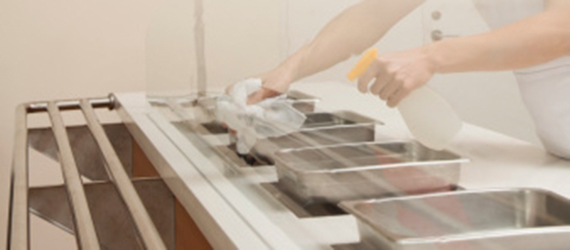The legal requirements and principles of the hygiene approach are similar to those for the wider food industry, details of which are available here

In the later stages of the food chain, such as in food retailing and catering operations, cleaning and disinfection procedures comprise five basic stages that are similar whatever the field of application, soiling type or circumstances:
- Pre-cleaning to remove any loose and heavy soiling.
- Main clean – wash with warm water and detergent.
- Rinse to remove any traces of detergent and soil with clean hot water.
- Disinfection, allowing sufficient contact time.
- Final rinse in clean hot water.
If the procedure uses a product which can both clean and disinfect at the same time, steps 2 and 4 are combined and step 3 is omitted.
For an introduction to the use of HACCP in food retailing and catering, click here and for a summary of typical key steps click here.
The examples below illustrate how these steps are applied in some common practical situations:
Cleaning a surface manually
- Remove loose soiling.
- Wash surface with warm water and appropriate detergent, using cloth scourer or mop.
- Rinse with hot water and a clean cloth.
- Apply a chemical disinfectant, following the manufacturers’ instructions.
- Rinse with clean water.
- Let dry in air or use a disposable paper towel.
‘Ware-washing’ – cleaning dishes and food-related equipment – by machine.
A machine can automatically perform all the necessary tasks, in the correct order, apart from the removal of gross soiling which needs to be done before loading. This depends, of course, on:
- the machine being loaded correctly.
- the correct dosage of chemicals being used (if not automated).
- the manufacturer’s instructions being followed.
- the necessary routine maintenance being carried out.
A key part of the service provided by I&I suppliers is the expertise, training and automatic dosing equipment to ensure the effectiveness of the machines.
Manual ‘Ware-washing’
- Wherever possible use two or three sinks side by side.
- Remove gross soiling – scrape and rinse if necessary.
- Wash the items, ideally in the first sink with lukewarm water and detergent, using a cloth or brush. Replace the warm water if it becomes cool or greasy.
- If the equipment is available, the items can be rinsed and disinfected in hot water at 82°C for at least 30 seconds.
- If this cannot be done safely then the items should be rinsed and then soaked in a chemical disinfectant following the manufacturer’s instructions.